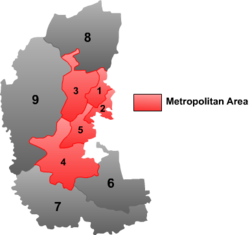
Guangzhou, also known as Canton, is the capital and most populous city of the province of Guangdong in southern China. On the Pearl River about 120 km (75 mi) north-northwest of Hong Kong and 145 km (90 mi) north of Macau, Guangzhou has a history of over 2,200 years and was a major terminus of the maritime Silk Road, and continues to serve as a major port and transportation hub, as well as one of China's three largest cities.

Shanghai is one of the four municipalities under the direct administration of the central government of the People's Republic of China, the largest city in China by population, and the second most populous city proper in the world, with a population of 24.18 million as of 2017. It is a global financial center and transport hub, with the world's busiest container port. Located in the Yangtze River Delta, it sits on the south edge of the estuary of the Yangtze in the middle portion of the West China coast. The municipality borders the provinces of Jiangsu and Zhejiang to the south, east and west, and is bound to the east by the South China Sea.

Guangdong, is a province in South China, on the South China Sea coast. Guangdong surpassed Henan and Shandong to become the most populous province in China in January 2005, registering 79.1 million permanent residents and 31 million migrants who lived in the province for at least six months of the year; the total population was 104,303,132 in the 2010 census, accounting for 7.79 percent of Mainland China's population. This also makes it the most populous first-level administrative subdivision of any country outside of South Asia, as its population is surpassed only by those of the Pakistani province of Punjab and the Indian states of Bihar, Maharashtra and Uttar Pradesh. The provincial capital Guangzhou and economic hub Shenzhen are among the most populous and important cities in China. The population increase since the census has been modest, the province registering 108,500,000 people in 2015.

Sichuan is a province in southwest China occupying most of the Sichuan Basin and the easternmost part of the Tibetan Plateau between the Jinsha River on the west, the Daba Mountains in the north, and the Yungui Plateau to the south. Sichuan's capital city is Chengdu. The population of Sichuan stands at 81 million.

Hebei is a province of China in the North China region. The modern province was established in 1911 as Zhili Province or Chihli Province. Its one-character abbreviation is "冀" (Jì), named after Ji Province, a Han dynasty province (zhou) that included what is now southern Hebei. The name Hebei literally means "north of the river", referring to its location entirely to the north of the Yellow River.

Shenzhen is a major city in Guangdong Province, China; it forms part of the Pearl River Delta megalopolis, bordering Hong Kong to the south, Huizhou to the northeast, and Dongguan to the northwest. It holds sub-provincial administrative status, with powers slightly less than those of a province.

Shandong, is a coastal province of the People's Republic of China, and is part of the East China region.
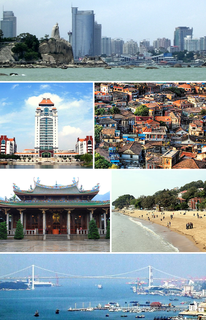
Xiamen (厦门) formerly known from its Hokkien pronunciation as Amoy [e˨˩ bŋ̍˨˨ ʨʰi˨˨], is a sub-provincial city in southeastern Fujian province, People's Republic of China, beside the Taiwan Strait. It is divided into six districts: Huli, Siming, Jimei, Tong'an, Haicang, and Xiang'an. Altogether, these cover an area of 1,699.39 square kilometers (656.14 sq mi) with a population of 3,531,347 as of 2010. The urbanized area of the city has spread from its original island to include parts of all six of its districts, with a total population of 1,861,289. This area connects to Quanzhou in the north and Zhangzhou in the west, making up a metropolis of more than five million people. The Jinmen or Kinmen Islands administered by the Republic of China lie less than 6 kilometers (4 mi) away.
Due to China's large population and area, the administrative divisions of China have consisted of several levels since ancient times. The constitution of China provides for three de jure levels of government. Currently, however, there are five practical levels of local government: the provincial, prefecture, county, township, and village.
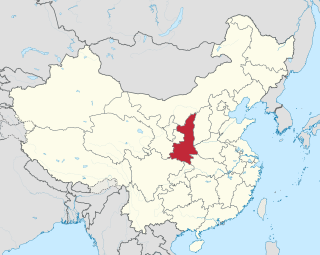
Shaanxi, is a province of the People's Republic of China. Officially part of the Northwest China region, it lies in central China, bordering the provinces of Shanxi, Henan (E), Hubei (SE), Chongqing (S), Sichuan (SW), Gansu (W), Ningxia (NW), and Inner Mongolia (N). It covers an area of over 205,000 km2 (79,151 sq mi) with about 37 million people. Xi'an – which includes the sites of the former Chinese capitals Fenghao and Chang'an – is the provincial capital. Xianyang, which served as the Qin dynasty capital, is located nearby. The other prefecture-level cities into which the province is divided are Ankang, Baoji, Hanzhong, Shangluo, Tongchuan, Weinan, Yan'an and Yulin.
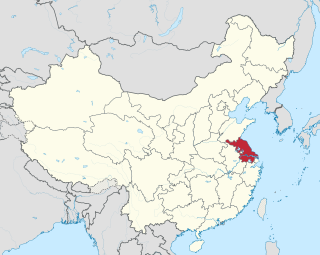
Jiangsu, is an eastern-central coastal province of the People's Republic of China. It is one of the leading provinces in finance, education, technology, and tourism, with its capital in Nanjing. Jiangsu is the third smallest, but the fifth most populous and the most densely populated of the 23 provinces of the People's Republic of China. Jiangsu has the highest GDP per capita of Chinese provinces and second-highest GDP of Chinese provinces, after Guangdong. Jiangsu borders Shandong in the north, Anhui to the west, and Zhejiang and Shanghai to the south. Jiangsu has a coastline of over 1,000 kilometres (620 mi) along the Yellow Sea, and the Yangtze River passes through the southern part of the province.

Luoyang is a city located in the confluence area of Luo River and Yellow River in the west of Henan province. Governed as a prefecture-level city, it borders the provincial capital of Zhengzhou to the east, Pingdingshan to the southeast, Nanyang to the south, Sanmenxia to the west, Jiyuan to the north, and Jiaozuo to the northeast. As of the final 2010 census, Luoyang had a population of 6,549,941 inhabitants with 1,857,003 people living in the built-up area made of the city's five urban districts, all of which except the Jili District are not urbanized yet.

Chongqing, formerly romanized as Chungking, is a major city in southwest China. Administratively, it is one of China's four municipalities under the direct administration of central government, and the only such municipality in China located far away from the coast.

Shenyang, formerly known by its Manchu name Mukden or Fengtian, is the provincial capital and the largest city of Liaoning Province, People's Republic of China, as well as the largest city in Northeast China by urban population. According to the 2010 census, the city's urban area has 6.3 million inhabitants, while the total population of the Shenyang municipality, which holds the administrative status of a sub-provincial city, is up to 8.1 million. Shenyang's city region includes the ten metropolitan districts of Shenyang proper, the county-level city of Xinmin, and two counties of Kangping and Faku.
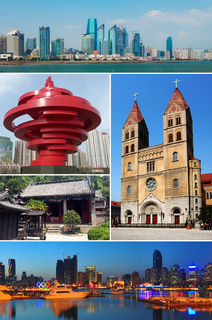
Qingdao is a major city in the east of Shandong Province on China's Yellow Sea coast. It is also a major nodal city of the One Belt, One Road (OBOR) Initiative that connects Asia with Europe. It has the highest GDP of any city in the province. Administered at the sub-provincial level, Qingdao has jurisdiction over six districts and four county-level cities. As of 2014, Qingdao had a population of 9,046,200 with an urban population of 6,188,100. Lying across the Shandong Peninsula and looking out to the Yellow Sea, it borders Yantai to the northeast, Weifang to the west and Rizhao to the southwest.

The United States Court of Appeals for the Ninth Circuit is a U.S. Federal court with appellate jurisdiction over the district courts in the following districts:

A prefectural-level municipality, prefectural-level city or prefectural city; formerly known as province-administrated city from 1949 to 1983, is an administrative division of the People's Republic of China (PRC), ranking below a province and above a county in China's administrative structure. Prefectural level cities form the second level of the administrative structure. Administrative chiefs (mayors) of prefectural level cities generally have the same rank as a division chief of a national ministry. Since the 1980s, most former prefectures have been renamed into prefectural level cities.
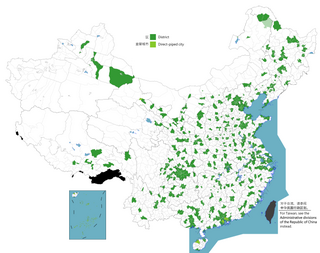
The term district, in the context of China, is used to refer to several unrelated political divisions in both ancient and modern China.

Beijing, formerly romanized as Peking, is the capital of the People's Republic of China, the world's third most populous city proper, and most populous capital city. The city, located in northern China, is governed as a municipality under the direct administration of central government with 16 urban, suburban, and rural districts. Beijing Municipality is surrounded by Hebei Province with the exception of neighboring Tianjin Municipality to the southeast; together the three divisions form the Jingjinji metropolitan region and the national capital region of China.
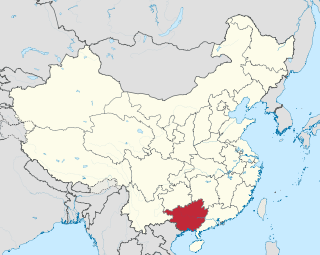
Guangxi ( ; formerly romanized as Kwanghsi; Chinese: 广西; Zhuang: Gvangjsih, officially the Guangxi Zhuang Autonomous Region, is an autonomous region of the People's Republic of China, located in south China and bordering Vietnam. Formerly a province, Guangxi became an autonomous region in 1958.

